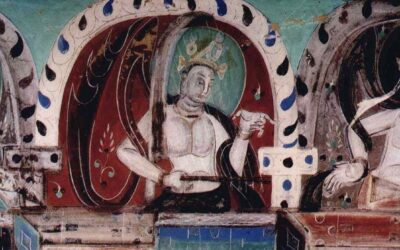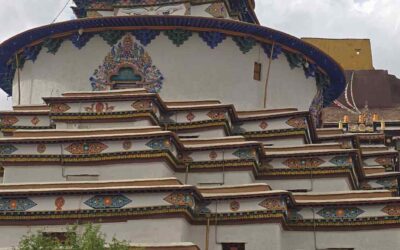The Canon of the Yellow Emperor
In Brief: The last great work of Chinese philosophy discovered so far, deserves to be known by all those interested in this country.
Almost 50 years ago, in 1973, an important quantity of artistic objects was discovered in an ancient tomb in southern China, in Mawangdui to be precise. Among them was a large silk fragment completely filled with Chinese characters. Scholars soon discovered that on the cloth was written a version of the Dao Dejing, the famous Taoist bible, as well as another initially unknown work.
Further research discovered that its character corresponded with the brief description in the Annals on Literature and Art, History of the Han Dynasty of «The Four Classics of the Yellow Emperor.» This is the basic work of the philosophical school called Huang-Lao, as it considered the Yellow Emperor (Huang Di) and the father of Taoism, Lao Zi, as its founders.
In fact, the use of these two names already gives an idea of the political character of the treatise, because based on these ancient roots it proposes a system of government (nothing further from the ideas of Lao Zi) capable of being compared with the Legist or Confucian system, dominant at the time. Based on the one hand on the love of the people, and on the harmony between the sovereign and his subjects, it maintains, on the other hand, the need for clearly established laws, and the need to establish severe punishments for those who do not comply with them.
The book is divided into four parts:
The Constant Laws assumes that laws, decrees, and legal institutions, are supported by the Dao. It has several chapters devoted to the Dao and the Laws, the order of a country, the correct kingship, of the ruin of countries, etc. It begins as follows:
«It is from the Dao that laws, decrees, and legal institutions take shape. Those laws are the rule for measuring what is just and what is not, profits and losses, and form the criterion for judging what is right and wrong. Therefore, he who masters the Dao formulates laws but dares not violate them.» (p. 3)
The Sixteen Classics, the second book, shows a series of scenes in which the Yellow Emperor lays the foundations of the Huang-Lao political system. He begins by describing the establishment of the mandate of heaven and goes on to propose a series of rules for good governance. It is interesting that in chapter seven, entitled «Paradigms of Male and Female Conduct», he continually praises female conduct, «modest, respectful and frugal», and says that «losses suffered due to female conduct will result in future rewards… and it is called the accumulation of virtues to suffer losses by persisting in female conduct» Further on he states «generally those who act first suffer bad fortune, while those who act later are assured of good fortune. And if one who acts first does not suffer bad fortune it is because he holds to feminine conduct» (p. 105).
«If one never suffers ill-fortune it is because he holds fast to the feminine conduct….. Anyone who is fond of applying masculine conduct should be called: one who is harmful to life….. Anyone who is fond of applying feminine conduct should be called a recipient of emoluments. If he is now rich, he will become richer; if he is poor he will have food to eat. If he defends himself, his defense will be stable; if he acts he will succeed; if he seeks something he will surely obtain it; his struggle will overcome his enemy.» (p. 106)
The third, Aphorisms, mixes some philosophical aspects with their practical application. Some are strange to the Western reader. Others contain teachings valuable in every time and continent:
«If there is no harmony in the internal affairs of a country, one should not speak of foreign affairs. If one does not carefully examine the details, one should not speak of great matters….. The grain that bears fruit need not have beautiful blossoms.» (p. 145).
And the last part, The Essence of the Dao, is a purely mystical disquisition of the Dao.
«One is its name. Emptiness its abode. Non-action its nature. Harmony its function.» (p. 159).
In short, a brief little work that presents hitherto unknown aspects of the philosophical thought of ancient China, whose reading is recommended for all those interested in delving into the essence of this culture.
The Yellow Emperor’s four canons. Revised, annotated and translated into modern Chinese by Yu Minggang. Translated into English by Leo S. Chang and Feng Yu. Yuelu Publishing House. Changsha, 2006.
Last posts
Dunhuang in the Silk Road
Dunhuang in the Silk RoadDunhuang is a city in the middle of the desert. Over its 2,000-year history, it has always been the last Chinese outpost before reaching the Western Regions—those kingdoms more or less dominated by the imperial regimes, yet showing customs so...
Discover China’s Largest and Most Beautiful Salt Lake
Discover China’s Largest and Most Beautiful Salt Lake The development of tourism and transportation in China is bringing to light places that were previously very hard to access and virtually unknown. Some of these destinations are beginning to gain a certain...
A Giant Mandala in the Heart of Tibet
A Giant Mandala in the Heart of Tibet The Palkor of Gyantze is one of Tibet’s great marvels and a unique jewel of universal architecture and art. Its shape, scale, and iconography defy comparison with any other construction. Amidst some of the highest mountains of...







